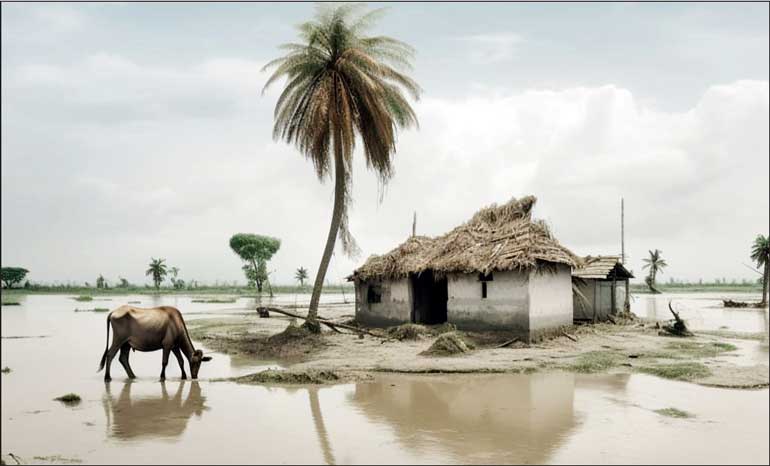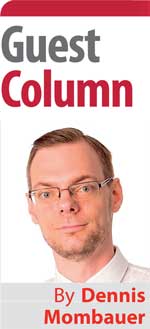Friday Jan 16, 2026
Friday Jan 16, 2026
Friday, 5 May 2023 00:40 - - {{hitsCtrl.values.hits}}

Where should funding for loss and damage come from, who should receive it, and how should it be distributed?
 At COP27 in November 2022, Parties to the United Nations Framework Convention on Climate Change (UNFCCC) and the Paris Agreement, including Sri Lanka, made the historic decision to establish funding arrangements and a dedicated fund for responding to climate-induced loss and damage (decisions 2/CP.27 and 2/CMA.4).
At COP27 in November 2022, Parties to the United Nations Framework Convention on Climate Change (UNFCCC) and the Paris Agreement, including Sri Lanka, made the historic decision to establish funding arrangements and a dedicated fund for responding to climate-induced loss and damage (decisions 2/CP.27 and 2/CMA.4).
While this marks an important turning point towards providing concrete support to climate-vulnerable developing countries, there are still many open questions regarding the operationalisation of a loss and damage fund and how to enhance the existing global finance system. A Transitional Committee with 24 members—representing all regions and both developing and developed countries—was established to answer these questions and present recommendations on how to establish the fund.
The Committee met for the first time from 27 to 29 March in Egypt, followed by a workshop in Bonn at the end of April. The second meeting of the Transitional Committee is now scheduled for 25 to 27 May in Bonn, right ahead of the UNFCCC Bonn Climate Change Conference in June, which will see a continuation of the COP27 negotiations. While this process is ongoing, there are many opportunities to contribute to it and help find answers to key questions.
Funding arrangements for loss and damage
The following three questions related to loss and damage funding could outline the scope of the work to be conducted: Where should funding come from, who or what should receive it, and how should it be distributed? Connected to this, it would also be important to understand the difference between loss and damage funding and other related forms of financing, such as for adaptation, disaster risk reduction, or humanitarian work.
Adding to this, loss and damage can take many different forms and impact households, communities, sectors, ecosystems, and national economies in different ways. For example, there are extreme weather events—floods, storms, landslides—, but also droughts and slow-onset processes such as sea level rise, coastal erosion, saline intrusion, increasing agricultural pests and diseases, melting glaciers, or shifting disease vectors. Loss and damage impacts people not only in terms of their livelihoods and assets, but can also have devastating consequences to health, wellbeing, cultural heritage, sense of place, natural ecosystems, and other non-economic aspects of life.
Assessing, understanding, and perhaps quantifying these impacts provides a basis to better answer the three questions above, although it should be done without posing additional burdens on those who are already vulnerable, and in a way that is transparent, inclusive, and participatory.
Sources of funding and funding arrangements
The UNFCCC published an initial synthesis report on existing funding arrangements and sources of finance that could be relevant for responding to loss and damage. Sources could include, for example, grants, taxes, carbon pricing, solidarity levies (such as those on aviation or shipping), debt swaps, social marketing, concessional loans (such as those under the IMF Resilience and Sustainability Trust), catastrophe bonds, climate bonds, impact bonds, equity investments, and co-investments. In addition, there are also concessional loans from the World Bank, grant-based co-funding from other sources (such as the Climate Justice Resilience Fund), and grants from different donors focused on addressing relevant aspects of climate-induced loss and damage.
In terms of funding arrangements, there is a multitude of instruments, mechanisms, tools, and systems that could be used to allocate, distribute, and disburse loss and damage finance. This includes insurance schemes, risk pools, social protection systems, cash transfer, emergency funding, microcredit, voucher systems, and other forms of support, such as healthcare, food assistance, temporary employment, psychosocial support, public works, or technology transfer.
During the recent workshop in the context of the Transitional Committee’s work, case studies from organisations and countries around the world were presented to an audience that included members and advisors of the Committee, showcasing existing arrangements as well as potential sources and entry points for enhancement. Presenting such case studies from vulnerable countries could help to further document and illustrate the need for loss and damage finance as well as possible mechanisms to bring said finance to those on the frontlines.
Working towards a global fund
The next meeting of the Transitional Committee will take place end of this month, and it will be followed by another round of negotiations among Parties to the UNFCCC and the Paris Agreement. For climate-vulnerable countries like Sri Lanka, it will be vital to see how a global fund and global funding arrangements can connect to the national level, where loss and damage is already taking place and draining Government budgets.
A loss and damage fund needs to contribute to filling these gaps in a fast, transparent, accountable, and efficient manner, ensuring that the money disbursed corresponds to needs on the ground in the context of increasing climate-induced loss and damage. Speed and accessibility are important criteria for a fund, which should be guided by considerations of justice, equity, and human dignity, including vulnerable groups and considerations related to gender, age, socioeconomic background, or disability.
Improved funding arrangements could be highly relevant for Sri Lanka by providing an additional avenue to access funding and address the impacts of climate-induced loss and damage with financial, technical, and capacity-building support as well as regional and global cooperation.
(The writer works as Director – Research and Knowledge Management at SLYCAN Trust, a non-profit think tank based in Sri Lanka. His work focuses on climate change, adaptation, resilience, ecosystem conservation, just transition, human mobility, and a range of related issues. He holds a Master’s degree in Education from the University of Cologne, Germany and is a regular writer to several international and local media outlets.)